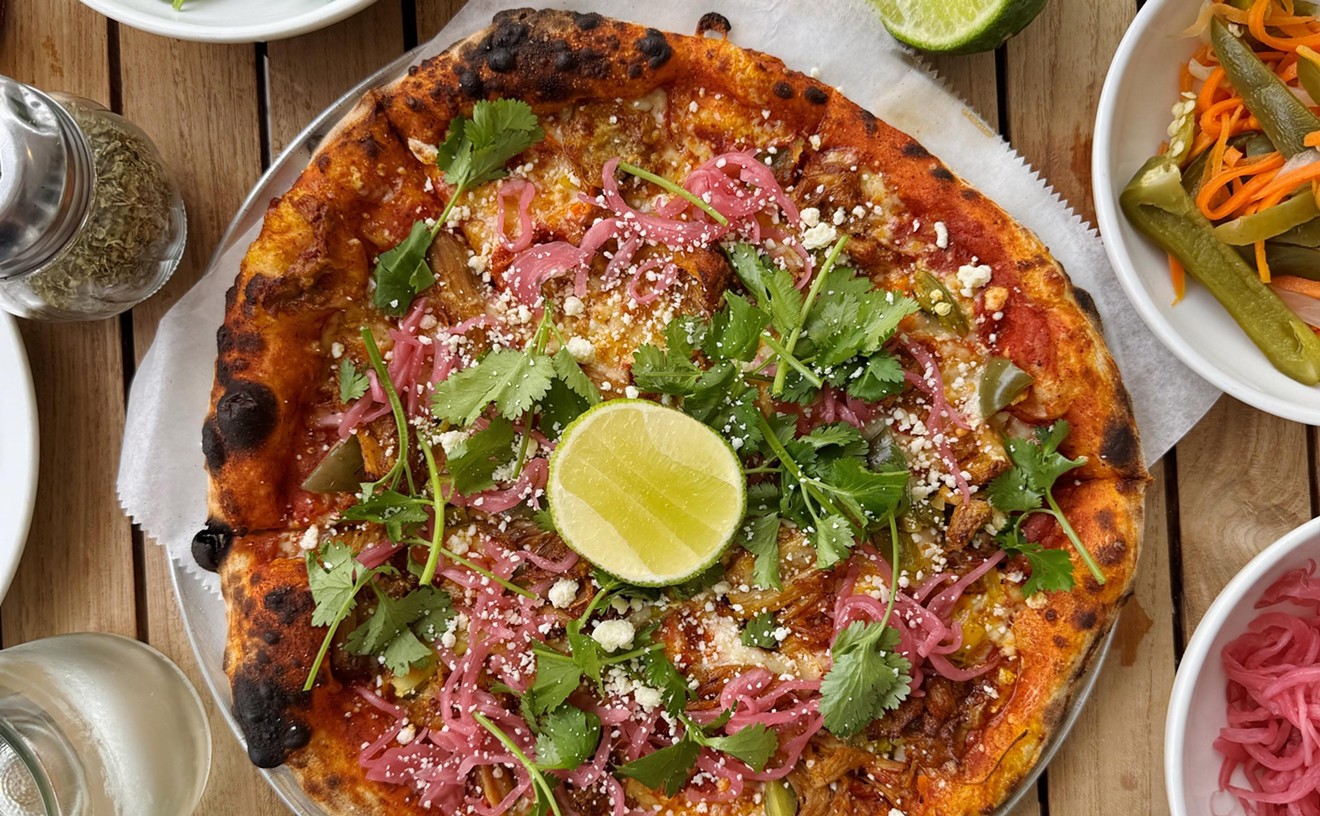The route from downtown Miami or South Beach to Buena Vista's restaurant strip traverses the posh Design District, a neighborhood speckled with Christian Louboutin stilettos and a luxury flagship shop by Hermès. Just a few blocks north is Little Haiti, where many families eke out a living with annual incomes lower than the average price of a Birkin handbag.
See also: Closer Look: The Embassy in Buena Vista
Between NE 42nd and 56th streets on Second Avenue, in the heart of Buena Vista, street lamps are scarce and potholes are plenty. Dingy markets contrast with the nearby upscale stores. But on the west side of the avenue, a restaurant row has sprung up with cuisines that bounce from French to Aegean to Japanese fusion. Intimate spaces, concise menus, and unfussy environs characterize the blithe, bohemian culinary vibe. It's the kind of place to visit when reservations-required South Beach or mustache-optional Wynwood just won't suffice.
On a recent Friday at 8 p.m., the pebbled parking lot near 46th Street was occupied by four or five cars. At Lemoni Café, families chatted over casual soups and sandwiches. Buena Vista Bistro buzzed with diners munching on escargots à la provençal and grouper with beurre blanc.
But nearby at the Embassy, a self-proclaimed gastropub that opened in December 2012, the setting was quiet and still. Through the windows, blue and black Arabic-style lamps illuminated an elfin, mismatched dining room. Printed across a black chalkboard, menu listings included lamb ragout with spaetzle, duck egg with clams and chorizo, and a barbecued wild boar sandwich. Two forgotten glasses of red wine rested atop a wooden table.
I pulled on the door's handle, but it wouldn't budge. There was no handwritten notice at the entrance or explanatory message on the answering machine. The restaurant was empty. The space was inexplicably closed.
"We had an emergency," Alan Hughes, chef and owner of the restaurant, said the following day. "We didn't even have time to leave a note."
Though he offered no further clarification, two things became clear: The weekend closure of Hughes's restaurant raises questions about his business acumen. It also might denote an eccentric and occasionally erratic persona. (Indeed, the chef describes himself as an "international man of mystery" on his website.)
An Argentine native with bushy eyebrows and ungroomed brown hair, Hughes speaks with an unidentifiable accent influenced by world travels. His culinary career began in 1989 under acclaimed gaucho chef Francis Mallmann in Buenos Aires. From there, the chef ventured to Madrid and then New York. In the Big Apple, he attended the French Culinary Institute and worked in kitchens for only a few months at a time. In less than 15 years, Hughes amassed an extensive resumé with stints in Spain, France, Jamaica, and elsewhere. "I changed a lot from restaurant to restaurant because I wanted to pick up as much knowledge as I needed," he said.
He established himself in Miami and in 2001, along with his then-wife Donna Freeman, opened One Ninety, a space heralded as the first chef-driven restaurant in the budding Buena Vista district. The funky vibe included eclectic cuisine, live music, and an ambiance studded with worn, dissimilar furnishings.
"Some people say I was ahead of the game, but I was just doing what people craved," he said. "I don't claim credit for the area. It was really about the desire to go to a place like the one we did. We had a freaking 100-year-old woman singing tango on some nights. We were authentic. We wanted fun, and that's all [One Ninety] was."
Three years later, in 2004, Hughes's landlord demanded a significant increase in rent. Despite a loyal following, the restaurant closed. During his hiatus from life as a restaurateur, the chef maintained a low profile and concentrated on catering and private gigs. In 2006, he reopened One Ninety in a seedier setting — this time in Little Haiti. After about a year, the real estate crisis forced the second reincarnation out of business.
Between 2008 and 2012, Hughes launched Luur, a setup of so-called guerrilla dinners where he prepared tasting menus in his catering space by reservation only. Then, last year, he took a chance with his latest restaurant, the Embassy.
Like One Ninety, the Embassy oozes a carefree vibe. Late-night dining pairs with a varied schedule of live music. On any given evening, there might be rock 'n' roll, Cuban son, or jams performed by Hughes himself. There is no stage; musicians strum guitars in a tight corner of the dining room. As for the food, Hughes's cooking still draws inspiration from around the globe.
But some things are different from earlier days at One Ninety. "I didn't want to do 'the Alan Hughes comeback' thing," he says. "I've warned people that they aren't going to get the full potential of my cuisine, just a version of it."
If that comment sounds like a preemptive excuse, it's because it is. At the 40-seat restaurant, the menu changes weekly. A single page, titled "Menu of Small Bites," lists fewer than 14 items. On my visits, two or three plates were sold-out — such as the duck egg and a brunch plate of house-made duck sausage. Across the bar, four platters were arranged with pintxos, a type of skewered snack popular in northern Spain, particularly the Basque country. One of the versions comprised a thick baguette slice topped with manchego cheese, serrano jam, shrimp, and a single olive. The open-faced sandwich, held together by a toothpick, was tainted by brittle, hardened bread. Another rendition, layered with goat cheese, roasted tomatoes, fresh anchovies, and aptly toasted baguette, proved substantially more delectable.
But the occasional tough pintxo is not the reason Hughes claims to be holding back on his full potential. The kitchen at the Embassy is equipped with only a fryer, an electric convection oven, and a small flattop. There is no open flame. Hughes practices cooking methods such as frying, braising, roasting, and baking. In the case of his small bites menu, those restrictions produce mixed success.
See also: Closer Look: The Embassy in Buena Vista
Rich stewed tomatoes, topped with capers, black olives, and a buttered slice of baguette, enveloped a luscious, flaky fillet of corvina. Although the menu listed rouille as a component of the dish, the sauce — composed of olive oil, breadcrumbs, garlic, saffron, and chili peppers — never arrived. It was unnecessary; the fish triumphed on its own. But paprika-dusted braised rabbit, paired with a Greek-yogurt-stuffed roasted red pepper and flavorless Israeli couscous, was underseasoned. Like other dishes I sampled at the Embassy, such as the poached eggs with braised greens and warm black rice salad, the rabbit lacked the excitement in execution that it inspired in concept.
Still, despite its flaws, the cuisine resonates with a comfortable, unfinicky charm.
"When I decided to open the Embassy, I knew I was going to get some hard reviews," Hughes said. "But I don't care what they say. This is a little experiment. This is just my neighborhood bar."
Like its owner, the Embassy is eclectic, imperfect, funky, and erratic. Some evenings, the music is weird, the food underseasoned, and the bread tough. But nights when Wynwood feels too artsy or the Design District seems too snazzy, Hughes's latest venture in Buena Vista is a hip, fascinating, and delightful place to visit.
If it's open, that is.









